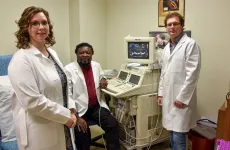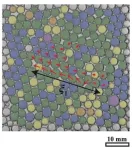Rapid, reliable on-site drug detection using wearable sensor
KIMS developed an optical sensor material for drug detection in sweat
2021-02-08
(Press-News.org) Researchers in South Korea have successfully developed a wearable sensor that can detect illegal drugs in sweat by using nanomaterials technology that amplify the optical signal of narcotics to a flexible, body-worn material. Led by Dr. Ho Sang Jung, the research unit is part of the Korea Institute of Materials Science(KIMS), a government-funded research institute under the Ministry of Science and ICT.
The technology enables fast and highly sensitive drug detection: the sweat patch is attached to the skin for a certain period of time and then irradiated with light for testing. It only takes one minute without requiring additional process.
Traditional drug detection process requires a complex method of extracting suspected drug components from biologic specimens including hair, blood, and urine, and then analyzing drugs through gas or liquid chromatography-mass spectrometry (GC/MS or LC/MS). It takes longer testing time and requires a large room for the instrument and skilled technicians. Although rapid kits can detect drugs in urine, they only detect a single component in a single test and have low sensitivity.
In the case of athletes, anti-doping drug testing is conducted to detect prohibited substances in blood and urine. Blood testing is often avoided due to concerns about decline in athletic performance, and urine testing may violate human rights as the tester must observe the athlete's urination. For the large sports events such as the Olympics, it is difficult to test all of the participants.
The researchers focused on sweat which is not invasive and relatively free from human rights issues. However, only small amount of substances is discharged in sweat, even though sweat contains various drugs taken so a highly sensitive sensor technology had to be developed for better detection.
The team's highly sensitive sensing utilized the surface-enhanced Raman scattering technology capable of enhancing the Raman signal of chemical substances by 1010 times and more. As the Raman scattering signal includes the specific signal of molecules, intuitive substance identification is possible no matter what drug is discharged.
The researchers paid attention to the cocoon protein, a flexible and wearable material to develop a wearable optical sensor. A silk fibroin solution, a natural protein, was extracted from silkworm cocoon to make a 160 nanometer (nm) thick film. The film was coated with 250 nanometers (nm) thick silver nanowire and transferred to the medical patch that can be attached to the skin.
Once the patch absorbs the sweat, the drug substance in the sweat penetrates the wearable sensor and reaches the silver nanowire. By irradiating the Raman laser on the patch, the drug can be detected in real time without removing the sensor.
This technology can help address social problems such as drug distribution and abuse related to celebrities, drug transactions in clubs, and the prohibited substance taken by athletes. Since the production cost is less than 50 cents per piece, it can be used for an anti-doping program as a complete enumeration survey during large sports events such as the Olympics.
Dr. Ho Sang Jung, the leader of research unit, said, "As seen in recent drug-related crimes, Korea is no longer a drug-free country. The developed technology would overcome the technological limitations on identifying drug and prohibited substance use and enable drug detection without invasive and ethical problems."
INFORMATION:
This work was supported by the Fundamental Research Program of the Korea Institute of Materials Science (KIMS) and funded by the Ministry of Science and ICT (MSIT). The article explaining results was published in ACS Applied Materials and Interfaces, a globally renowned academic journal on January 6, 2021. The technology was patented in South Korea and has been applied for a US patent.
Based on this project, the researchers are actively developing wearable healthcare sensors that enable rapid testing of metabolites related to diseases.
Glossary description:
* Gas or liquid chromatography-mass spectrometry: an analytical method to identify different substances within a test sample by extracting substances, separating the mixture, measuring molecular weight, etc.
* Surface-enhanced Raman scattering: a technology to amplify molecular signal to 109 - 1011 times. The electromagnetic field enhancement phenomenon on the noble metal nanoparticle surfaces is applied to the development of ultra-sensitive sensors.
* Silk fibroin: the fibroin protein extracted from silkworm cocoon
* Silver nanowire: nanowire made of silver with diameters that are dozens of nanometer, and lengths of few micrometer
About Korea Institute of Materials Science (KIMS)
KIMS is a non-profit government-funded research institute under the Ministry of Science and ICT of the Republic of Korea. As the only institute specializing in comprehensive materials technologies in Korea, KIMS has contributed to Korean industry by carrying out a wide range of activities related to materials science including R&D, inspection, testing&evaluation, and technology support.
[Attachments] See images for this press release:

ELSE PRESS RELEASES FROM THIS DATE:
2021-02-08
Online searches for mobile and isolated activities can help to predict later surges and declines in COVID-19 cases, a team of researchers has found. Its findings, based on a four-month analysis of online searches, offer a potential means to anticipate the pathways of the pandemic--before new infections are reported.
"This is a first step towards building a tool that can help predict COVID case surges by capturing higher-risk activities and intended mobility, which searches for gyms and in-person dining can illuminate," says Anasse Bari, a clinical assistant professor in computer science at New York University's Courant Institute of Mathematical Sciences ...
2021-02-08
AUGUSTA, Ga (Feb. 8, 2021) - Starting with early childhood, otherwise healthy Black people show signs of slightly diminished heart muscle strength and a slightly higher blood pressure than their white counterparts, factors which may put them on a course for early development of congestive heart failure, researchers report.
The take-home message for parents and physicians is that, particularly for populations at high cardiovascular risk such as Black people, a close check should be kept on blood pressure starting in early adolescence, says the corresponding author of the study in Journal of the American Heart Association.
Children ...
2021-02-08
Efforts to improve the social success of autistic adolescents and adults have often focused on teaching them ways to think and behave more like their non-autistic peers and to hide the characteristics that define them as autistic. Psychology researchers at The University of Texas at Dallas, however, have been focusing on another approach: promoting understanding and acceptance of autism among non-autistic people.
The researchers published their findings online Jan. 20 in the journal Autism. The study showed that familiarizing non-autistic people with the challenges and strengths of autistic people helped to reduce stigma and misconceptions about autism, but implicit biases about autism were harder to overcome.
Desiree Jones, a psychology doctoral student ...
2021-02-08
Beer-Sheva, Israel...February 8, 2021 - A new discovery by researchers from Ben-Gurion University of the Negev (BGU) and its affiliated Soroka University Medical Center shows that medical cannabis may reduce blood pressure in older adults.
The study, published in the European Journal of Internal Medicine, is the first of its kind to focus on the effect of cannabis on blood pressure, heart rate and metabolic parameters in adults 60 and above with hypertension.
"Older adults are the fastest growing group of medical cannabis users, yet evidence on cardiovascular safety for this population is scarce," says Dr. Ran Abuhasira of the BGU Faculty of Health Sciences, one of Israel's leading medical ...
2021-02-07
It's well understood that a difficult childhood can increase the likelihood of mental illness, but according to new research from the University of South Australia, a happy and secure childhood does not always protect a child from developing a mental illness later in life.
Conducted in partnership with the University of Canberra, the finding is part of a study published in Current Psychology, which examined how early childhood experiences relate to different developmental pathways, and how these might be associated with poor mental health.
Given that both positive and negative childhood experiences were found to manifest as anxiety or other mental health disorders into adulthood, ...
2021-02-06
Tokyo, Japan - Researchers from Tokyo Metropolitan University studied the dynamics of foams. When a drop of water was added to a foam raft, the bubbles rearranged themselves to reach a new stable state. The team found that bubble movement was qualitatively different depending on the range of bubble sizes present. Along with analogies with soft-jammed materials, these findings may inspire the design of new foam materials for industry.
Foams are everywhere. Whether it's soaps and detergents, meringues, beer foam, cosmetics or insulation for clothing and building, we're surrounded by everyday ...
2021-02-06
There is an urgent need for guidelines on how schools can use ventilation to reduce the risk of COVID-19 transmission in the classroom, according to doctors at Imperial College London and the headteacher of a secondary school in Pinner, Middlesex. In a commentary published by the Journal of the Royal Society of Medicine, the authors say that improving air quality in classroom spaces should be as important as following government advice regarding social distancing, mask-wearing and hand washing.
The authors point to lessons from the airline industry, where the risk of contracting COVID-19 on a flight ...
2021-02-06
6 February: The IMbrave150 trial found median overall survival was 19.2 months in patients treated with atezo+bev vs 13.4 months for those treated with sorafenib alone, the current standard treatment (HR, 0.66 [95% CI, 0.52-0.85]; P=0.0009). Survival at 18 months was 52% with atezo+bev and 40% in patients treated with sorafenib.
All patients in the trial had nonresectable HCC - the most common form of liver cancer - and had not previously been treated with systemic therapy. A total of 501 patients were treated in the multicentre, open label, randomised controlled trial and the new follow-up figures confirm the superiority of the atezo+bev combination over sorafenib in this group of patients with HCC.
Atezolizumab is an immune ...
2021-02-06
Around one in three working-age adults (29%) surveyed in France in July 2020 would refuse any COVID-19 vaccine.
Willingness to receive a COVID-19 vaccination depended upon its country of origin, effectiveness, rate of serious side effects, and site of vaccination.
Although attitudes may have changed since July 2020 with the approval of several vaccines and a second wave of COVID-19, the findings suggest that communicating the collective benefits of herd immunity reduced people's hesitancy about being vaccinated.
Nearly one in three working-age adults in France (29%) surveyed in July 2020 - when lockdown restrictions had been ...
2021-02-06
TORONTO (February 5, 2021) - A clinical study led by Dr. Jordan Feld, a liver specialist at Toronto Centre for Liver Disease, University Health Network (UHN), showed an experimental antiviral drug can significantly speed up recovery for COVID-19 outpatients - patients who do not need to be hospitalized.
This could become an important intervention to treat infected patients and help curb community spread, while COVID-19 vaccines are rolled out this year.
"This treatment has large therapeutic potential, especially at this moment as we see aggressive variants of the virus spreading around the globe which are less sensitive to both vaccines and treatment ...
LAST 30 PRESS RELEASES:
[Press-News.org] Rapid, reliable on-site drug detection using wearable sensor
KIMS developed an optical sensor material for drug detection in sweat




